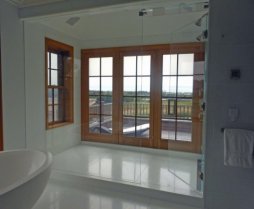Glass is available in a number of tints which absorb a portion of the solar heat and block daylight. Tinting changes the color of the window and can increase visual privacy. The primary uses for tinted glass are reducing glare from the bright outdoors and reducing the amount of solar energy transmitted through the glass.
Tinted glazings retain their transparency from the inside, although the brightness of the outward view is reduced and the color is changed. The most common colors are neutral gray, bronze, and blue-green, which do not greatly alter the perceived color of the view and tend to blend well with other architectural colors.
Tinted glass is made by altering the chemical formulation of the glass with special inorganic additives. The color is durable and does not change over time. Its color and density changes with the thickness of the glass. Coatings can also be applied after manufacture. Every change in color or combination of different glass types affects visible transmittance, solar heat gain coefficient, reflectivity, and other properties. Glass manufacturers list these properties for every color, thickness, and assembly of glass type they produce.
Tinted glazings are specially formulated to maximize their absorption across some or all of the solar spectrum and are often referred to as heat-absorbing. All of the absorbed solar energy is initially transformed into heat within the glass, thus raising the glass temperature. Depending upon climatic conditions, up to 50% of the heat absorbed in a single pane of tinted glass may then be transferred to the inside via radiation and convection. Thus, there may be only a modest reduction in overall solar heat gain compared to other glazings. This heat gain from absorption that is transmitted to the room leads to discomfort near tinted windows as well. Heat-absorbing glass provides more effective sun control when used as the outer layer of a double-pane window. Traditional tinted glazing, bronze and gray, often force a trade-off between visible light and solar gain. There is a greater reduction in visible transmittance than in solar heat gain coefficient (see figure to the right). This can decrease glare by reducing the apparent brightness of the glass surface, but it also diminishes the amount of daylight entering the room. For windows where daylighting is desirable, it may be more satisfactory to use a high-performance tint or coating along with other means of controlling glare. Tinted glazings can provide a measure of visual privacy during the day, when they reduce visibility from the outdoors. However, at night the effect is reversed and it is more difficult to see outdoors from the inside, especially if the tint is combined with a reflective coating.










We are experts in window film applications which will provide daytime privacy. The physics of tinted glass or window films is exactly the same..so:
It isn't the tint that creates the mirror effect it's the metals in the glass coating or inter-layer or the film that reflect light and heat. In the daylight hours thyere would be privacy . At night the opposite unless you shine lighting diirectly at the glass from the exterior.
There are tinted films that have zero metals (ceramic films) like Huper Optik that can reduce the reflectivity of glass while rejecting heat, etc . These films and…